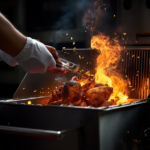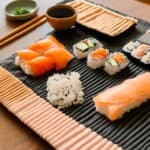
Are you tired of your cakes sticking to the pan and coming out in pieces?
According to a seasoned baker, the key to greasing cake pans is to use a combination of butter and flour. This tried and true method ensures that your cakes will easily release from the pans, resulting in perfect, professional-looking creations every time. (1)
Now, we will walk you through the expert-recommended technique for greasing cake pans, complete with tips, tricks, and secrets to guarantee baking success. So, grab your butter and flour, and let’s get started!

KEY TAKEAWAY
How to Grease Cake Pans?
To grease cake pans, thoroughly coat the entire interior of the pan, including the bottom and sides, with a thin layer of butter, shortening, oil or non-stick baking spray. It’s important to apply the grease or oil evenly so the cake batter doesn’t stick during baking.
Why Greasing Cake Pans is Important
Greasing cake pans prevents cake batter from sticking and makes it easy to remove the finished cake. Batter sticks easily without protection from the pan’s surface. Some greasing options include butter, oil, shortening or non-stick cooking spray. If the batter sticks, it can tear the cake and make it look unappealing or cause frustrations. Greasing the pans lightly and evenly is an important step to achieving perfect cakes each time.
Taking a few minutes to properly grease pans pays off with stress-free baking. Cakes release smoothly for easy transfer without risk of damage. The end product looks professionally done rather than scarred from pan wars. No one wants to serve a cake marred by sticking problems that could have been avoided with simple pan preparation.
Different Ways to Grease Cake Pans
Butter and oil leave behind residue that shortening and sprays avoid, so choose wisely depending on the cake recipe. For chocolate cake, cocoa powder mixed into grease creates a moisture barrier. Nonstick sprays are quick but butter or oil provide better release for intricate pans. Each method has benefits so consider your specific needs for the best results.
Experimenting with different greasing techniques allows bakers to find their favorite. Some appreciate the slickness of spays while others swear by traditional sticks. Recipe ingredients also factor in, like natural butters complementing nut-based batters. Diversity encourages creativity in both baking methods and delicious treats.
Preparing Cake Pans for Greasing

First, wash pans with warm, soapy water and a cloth, rinsing well to remove residue. Let air dry completely before greasing to ensure water doesn’t interfere. For reusable pan release recipes, apply a thin coating to the bottom and sides before each use. This keeps pans in top functioning form each use without added effort.
Thorough cleaning without water spots maximizes the effectiveness of fresh grease later. Drying fully protects against potential sogginess too. Lightly coating prevents scratching that worn surfaces can cause over time. With this simple prep work, pans stay in great shape for consistent results batch after batch.
Greasing Cake Pans with Butter or Shortening
Use softened butter or shortening and a pastry brush to coat the inside of the pan. Thoroughly butter even the tightest nooks and crannies to avoid patches where batter can stick. This thin, even layer slicks up the pan. Precise coating takes extra minutes but avoids peeling messes later.
Pastry brushes smoothly distribute a light sheen without drips. Taking time to brush into all corners means cakes release as intended. A uniform coat prevents batter from bonding anywhere to pans. After baking, cakes just lift out cleanly first try.
Greasing Cake Pans with Non-Stick Cooking Spray
A quick spray of nonstick cooking spray gives a slick surface and no mess. Evenly mist the entire pan including its sides and bottom. Avoid drips by spraying outdoors or near an open window. Let pan fully dry before adding batter. The dry and slick surface provides a protective barrier.
While a fast method, spraying properly is important. Hold can 6-8 inches away and sweep mist in a side to side motion. Only a light coating prevents oil puddling that leads to soft spots. Consistent covering with a short drying break makes clean releases guaranteed.
Greasing Specialty Cake Pans
Complex shapes like bundt and tube pans require extra care. Generously brush sides and make sure batter won’t get stuck in or over edges. Use chocolate hazelnut spread for rich chocolate buttercream. Folding a piece of parchment paper underneath solves stuck designs. Special pans need love too for picture-perfect baked goods.
Intricate nooks on these pans seem impossible to reach but taking time pays off. Brush from multiple angles getting into each contour ensures steady releases. Tricks like parchment protect intricate details so cakes emerge beautifully intact as intended. Creativity plus preparation makes success attainable.
Common Mistakes to Avoid When Greasing Cake Pans
Forgetting corners or edges leads to stuck goods that tear removing. Applying uneven coats makes batter pool unevenly. Using butter after spraying introduces moisture from both. Letting pans sit greased invites batter bonding before baking. Always grease fully, then flour pans and tap out excess for perfect results.
Thoroughly coating every interior surface, including corners and edges, is key to smooth releases. Uneven layers can cause tearing or bald spots. Too much residual moisture compounds sticking issues as well. Letting pans sit too long allows grease to be partially absorbed before use.
Troubleshooting Tips for Stuck Cakes
If baked goods stick, let cool completely before removal. Run a knife between edges, heating with a hairdryer if stubborn. A graham cracker or cookie base prevents sticking in cheesecakes. Freezing rather than greasing works for no-fuss cookie removal too.
Patience is important when removing stuck treats. Forcing can damage both pan and product. Low heat helps release bonds with care taken not to scorch. Crusty bases supply a non-stick layer that thick mixtures cling less to. Freezing relaxes bonds for easy lifting without extra mess.
Conclusion
In conclusion, greasing cake pans is a simple yet essential task that every baker should master. By taking the time to grease your pans correctly, you’ll ensure that your cakes turn out beautifully every single time.
So go ahead and give it a try, and don’t forget to let us know in the comments how it worked out for you. Happy baking!
Frequently Asked Questions
How should I prepare cake pans before greasing?
It’s important to wash cake pans thoroughly before greasing to remove any residue. Make sure to dry the pans completely before applying grease or oil. Clean pans ensure proper release.
How should I grease my cake pans?
Generously grease the entire inside surface of pans including the bottom and sides using butter, oil, shortening or nonstick spray. Apply in an even, thin layer. Flouring the greased pans further ensures cakes don’t stick.
Can I use parchment paper instead of greasing?
Lining pans with parchment is a great grease-free method. Cut paper to fit the bottom, allowing excess to line the sides. Batter won’t stick and cakes lift out easily after baking.
How do I grease pans for layered cakes or bundt cakes?
Specialty pans require extra care. Generously grease crevices and pour batter slowly to fully cover all surfaces. Parchment works too but is more likely to tear intricate surfaces.
Can I grease pans ahead of time?
It’s best to grease pans just before adding batter so it doesn’t have time to soak in. If prepping early, store greased pans wrapped to maintain their non-stick properties until use.
What if my cake is sticking after baking?
Let the cake fully cool before loosening or removing from pans. (2) Run a knife around the edges then invert to release. Re-greasing or spraying pans can also help loosen.
Do I need to grease non-stick pans?
While not required, a light greasing provides extra insurance against sticking. The non-stick surface may deteriorate over time or high heat, and greasing maintains optimal release for baked goods.
Any tips for greasing special pans like bundt or tube pans?
Give intricate patterns and crevices extra attention when greasing. Use a pastry brush or small piece of paper towel to access all surfaces. Parchment provides release protection for detailed designs.
- You may like: Crepe Maker, Superb 7 Facts Of Crepe Maker That You Should Know!
- You may enjoy this article about: What Size Pizza Peel Do I Need? 6 Superb Facts That You Need To Know About It
- This article may be interesting: How Much Does A Convection Oven Cost? Here Are Superb 3 Consideration Before Buying It
Was this helpful?

I’m Mary R. Q. , a seasoned professional chef dedicated to elevating home cooking experiences. Through my expertise in the culinary arts, I provide practical cooking tips and insightful reviews of kitchen utensils on my blog, milkwoodrestaurant.com. As a passionate advocate for transforming everyday meals into extraordinary culinary adventures, I aim to empower home cooks with the knowledge and tools they need to create delicious and memorable dishes. I’m also an author of the book “1,001 Kitchen Tips & Tricks: Helpful Hints for Cooking, Baking, and Cleaning (1,001 Tips & Tricks)” which is sold on Amazon. Join me on a flavorful journey as we explore the art of cooking and the essential tools that make it a joy.








